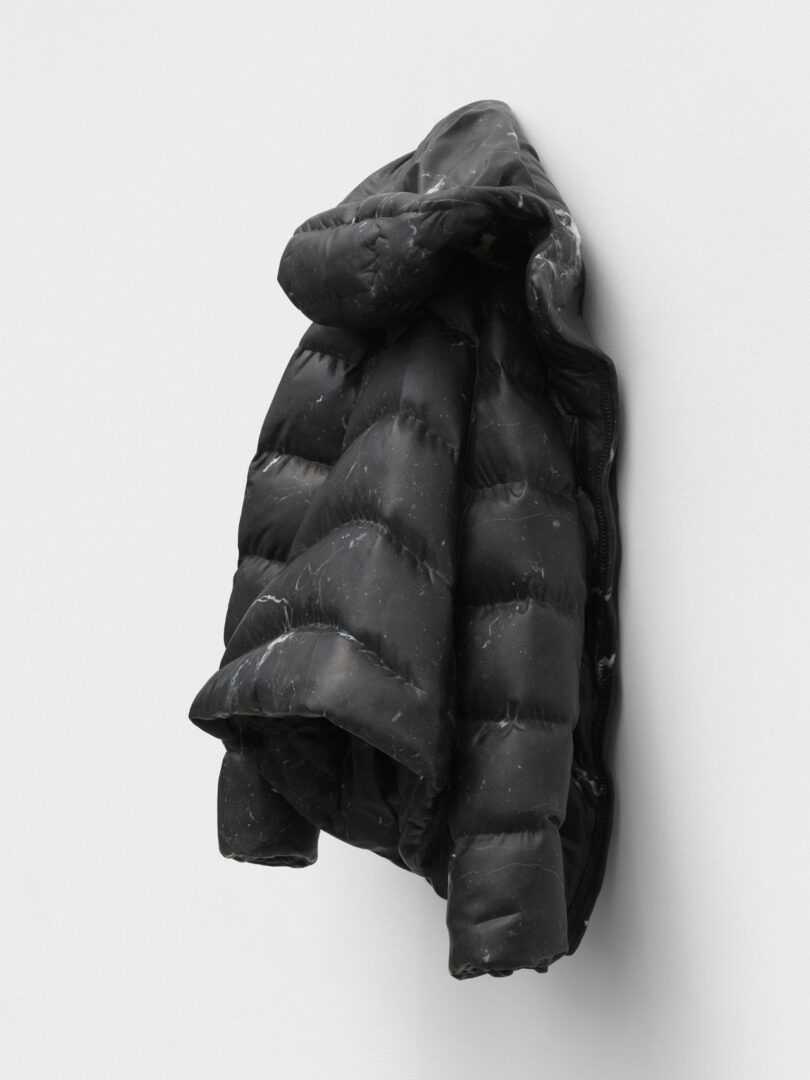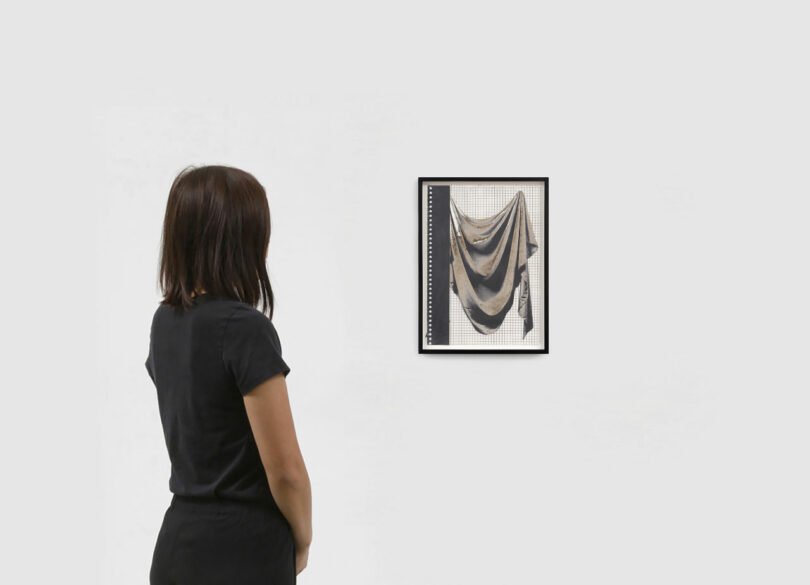A marble hyper-realistic carving of a jacket and exceptional paintings created on a loom are just the begining of Analia Saban’s new exhibition Flowchart, on view at Tanya Bonakdar Gallery in New York. Born in Argentina and working in Los Angeles, the artist is known for her material-enticing collisions of art and technological histories, infecting curiosity to deliver one of the most unique contemporary art experiences on view now. And it all gets better the closer you look.
The exhibition opens with a casual-seeming puffer jacket hanging on the wall. Titled “Puffer (Patagonia, Nero Marquina),” it’s a hyper-realistic sculpture in black Nero Marquina marble, carved by both robotic technology and human hand. It’s a bridge across technology and time, referencing the material of ancient sculpture and the subject of modern fashion. Here it also functions as an encouragement, or maybe a warning, to look closer, find material friction, and be ready for anything.
Three large orange paintings are a visual magnetic pull into the first room. Each titled “Woven Three-Blade Fan (Fluorescent Orange),” Saban creates the works by weaving long dried snakes of orange acrylic paint with threads of linen using a loom. The most basic idea of “paint on canvas” now becomes a single material-hybrid of the two, with a subtlety of gradation that defies the rigid binary grid system of a loom.
Analia Saban’s artwork was the first to introduce me to the historical connection between looms and computer code with her 2018 exhibition Punched Card, exploring the fact the computer language of ones and zeros originated from earlier loom technology. For these new near-glowing orange works, the press release notes that they “evoke the energy and heat generated by the massive servers that power today’s digital networks.”
Nearby, black paintings resemble the scale of university chalkboards. Saban creates these by scratching into a layer of black oil stick she applied over white encaustic. The resulting “flowcharts” describe a complex network of decisions to create a work of art in various subject categories. For example, “Flowchart (Painting Gesture)” begins with a simple “start” bubble in the top left to wind through an overwhelming path of considerations and functions. It feels somewhere between an advanced equation that barely fits on a chalkboard and the interworking of a computer assigning logic to magic.
Upstairs, five additional “Flowcharts” reach over nine feet tall. These works also describe a network of apparent decisions in the creation of a painting, but lack any words at all. Each however, hints at their subject (and title) if you look closer. For example, “Tapestry (Flowchart, Anatomy)” (below), reveals a human form in the lower half of the work.
The last room displays a grid of 18 “drawings,” made from laser-cut notebook paper. At first glance, they read like standard drawings on paper, but the “white” sections are actually highly-precise cut-outs, revealing the white backing board behind the paper. Some areas are blackened with graphite while other areas are brown with only a gentle toasting.
Analia Saban’s work re-merges the histories and materials of the computer, textile, and paint while also emanating a joy for both the mind and the eyes. Check out all the various flowcharts and laser-cut papers in real life (or posted on the exhibition website here) through December 18, 2025.
What: Analia Saban: Flowchart
Where: Tanya Bonakdar Gallery, 521 W 21st Street, New York, New York
When: October 30 – December 18, 2025
All images courtesy the artist and Tanya Bonakdar Gallery, New York. Installation images photographed by Dan Bradica.
















 FANTESTICRYAN Small Animal Statues Home Decor Modern Style Black Decorative Ornaments for Living Room, Bedroom, Office Desktop, Cabinets…BUY NOW
FANTESTICRYAN Small Animal Statues Home Decor Modern Style Black Decorative Ornaments for Living Room, Bedroom, Office Desktop, Cabinets…BUY NOW






